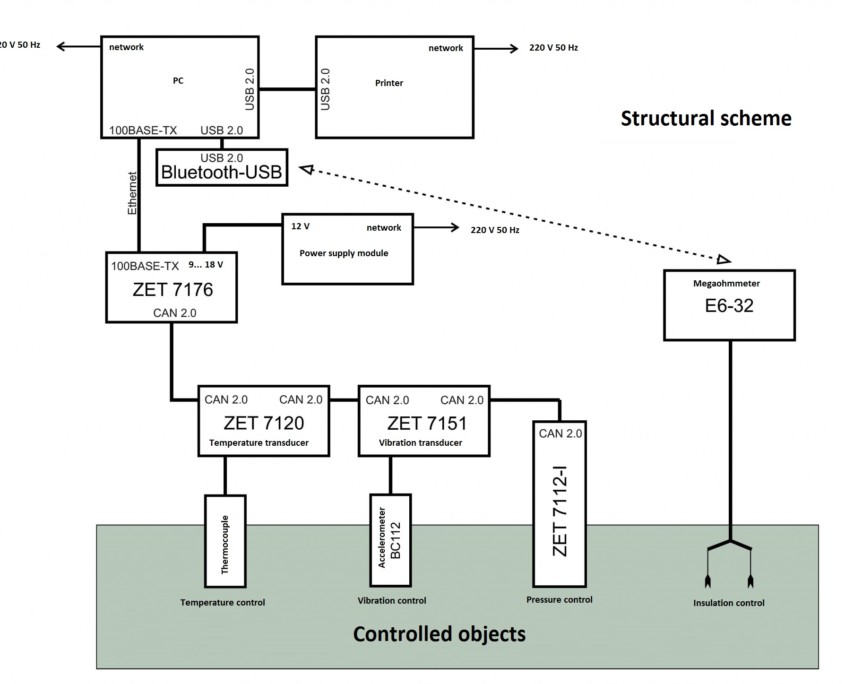Pumps at petroleum installations vibration-based diagnostics
The maintenance service of aggregates in the industry is very often carried out only after the scheduled mandatory inspections, i.e. the disassembly of the devices is performed only as a routine inspection followed by repair where necessary. Such an approach to repair works cannot prevent the unexpected damage to the parts that are subject to wear, but on the contrary, it only accelerates their wear. In addition, an improper assembly after a maintenance inspection causes the subsequent deformation, thus reducing the lifetime of the machine.
This problem can be solved through organizing parameter changes continuous monitoring in the state of a device. Such a method is particularly recommended for use with expensive items, the collapse of which might stop the entire production process.
One of the best sections of the technical diagnostics that provides the operational control over the parameters of the current state of the machine equipment during the operation without dismantling is the vibration-based diagnostics. The analyzed parameter of which is the vibroacoustic signal containing information on the oscillatory process.
Let us consider the example of pumping units at petroleum installations vibration-based diagnostics.
The petroleum installations are equipped with different types of pumping stations, which are the most important facilities designed for oil and other fluids transfer and supply. Vibration of pumps is the main indicator, which should be monitored by means of measuring devices at regular intervals.
The vibration diagnostics of the electromotors of pumps allows to detect emerging defects, helps to prevent their development and get down to repairing based at the actual technical condition. Thus, a timely verification secures the safety and prevention of accidents during petroleum products transportation.
The information obtained from the sampling points and measurement directions should be used to detect the defects of the unit, whether vertical, horizontal or axial vectors are. Fast spasmodic shifts signal a disorder process in the mechanism. Identification of the causes of damages, i.e. statement of a fault diagnosis, based on the analysis of the signal’s varying parameters.
The control is carried out according to the following parameters of vibration:
- instantaneous values
- crest values
- RMS
- basic tone frequency and harmonics
- steepness of rising edge and pulse duration of an action
- spectral characteristics
There exist a great amount of electrical transformers that convert mechanical vibrations into an electrical signal: piezoelectric, inductive and eddy-current, capacitive, piezoresistive, etc.
Unlike other types, the piezoelectric accelerometers are effective in the measurement of vibrational quantities nearly within any required frequency and dynamic ranges. Such sensors are often used to measure the mechanical vibration and strokes.
The pumps are divided into two types: dynamic and voluminous. The dynamic ones are subdivided as follows: centrifugal, axial, regenerative auger-type pumps, jet-type pumps. The voluminous ones are divided into the piston type, screw type, manual ones.
Since the pumping unit represents a frame with the elements clamping to the foundation from the receiving-outleting pipeline to the collector, during the operation of pumps the frame is exposed to strong vibrations. Measuring and monitoring of such vibration parameters can be carried out with the help of accelerometers BC 110.
In order to evaluate the stiffness of the frame clamping to the foundation the vibration at all elements of pump mounting to the foundation is measured. The measurement is performed in the vertical direction at the screw-in anchors (heads) or next to them on the foundation at a distance of not more than 100 mm from them. The measurement is carried out during the scheduled and not scheduled vibration diagnostic inspection. The most important and reliable sign of disorders stiffness is the change in the nature of vibration when passing through the defective junctions. To detect them the contour characteristic must be sampled in different locations of the facility and its elements by measuring the amplitude and phase of the vibration at the first (and sometimes higher) harmonica.
The rotor pump system is also exposed to an intense vibrations, it constitutes the rotors of an electromotor and a pump connected by a flexible coupling and the bearing liners.
In case of a continuous operation of both types of pumps the wear of bearings occurs, resulting in an excessive vibration of the unit. The long operation of the worn bearings brings to a rotor’s misalignment, the consequences of which are: power consumption growth, an increased overheating of bearings and racks, impeller against the body frame scrapping.
Misalignment and scrapping against body frame of the gland sealing of the units can be either detected or prevented using the accelerometers BC 111, which are installed in the three mutually perpendicular axes of the motor bearings and the pump itself. The bearings condition is estimated in 4 frequency ranges based on the results of a digital processing of the sensor signals
The accelerometers applied during the measurements and analyses are connected to the spectrum analyzer ZET 017-U8 without any preamplifiers. The spectrum analyzer supports measuring transducers and contains the power source; it converts the analog signal into a digital sequence and transmits the signals for further processing on a PC with installed ZETLab software. The analyzer supports standard interfaces for the connection to a PC: USB, Ethernet, Wi-Fi.
To the spectrum analyzers there can also be connected other measuring devices for a more detailed diagnostics of pumps, thereby achieving a minimum cost rate for the monitoring and diagnostics of a large number of equipment remotely located from each other.
The system assembled using our measurement equipment ensures:
- possibility of storing large amount of information, without any distortion and losses
- multichannel operation with a possibility of parallel recording and analyzing signals
- carrying out most of the existing types of signal analysis
It is also possible to assemble the measurement system with the help of smart sensors, as shown in the figure:

The vibration-based diagnostics equipment is widely used in the oil and gas (compressors), chemical (pumps), energy (turbines), metallurgy (driving mechanisms), shipbuilding (engines), aircraft manufacturing and other industries.
